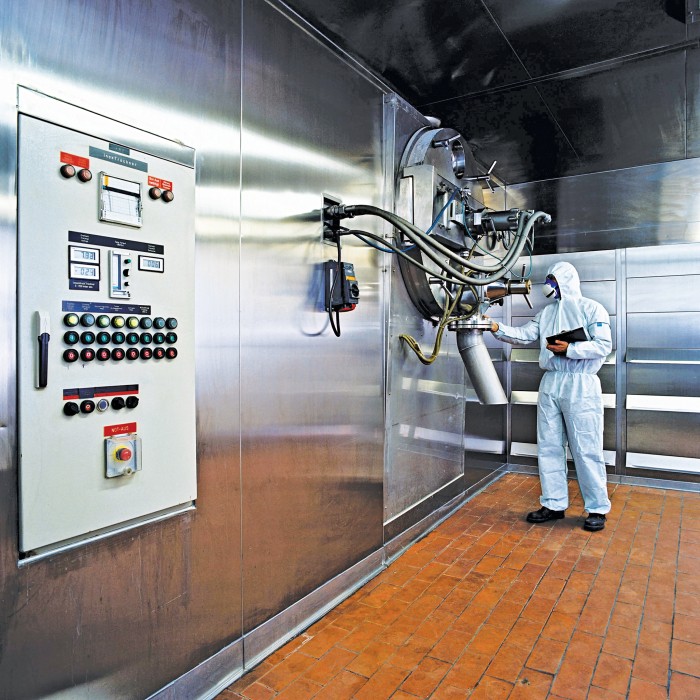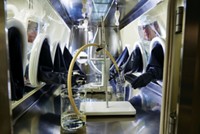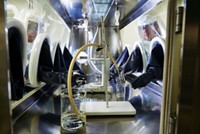Advertisement
Grab your lab coat. Let's get started
Welcome!
Welcome!
Create an account below to get 6 C&EN articles per month, receive newsletters and more - all free.
It seems this is your first time logging in online. Please enter the following information to continue.
As an ACS member you automatically get access to this site. All we need is few more details to create your reading experience.
Not you? Sign in with a different account.
Not you? Sign in with a different account.
ERROR 1
ERROR 1
ERROR 2
ERROR 2
ERROR 2
ERROR 2
ERROR 2
Password and Confirm password must match.
If you have an ACS member number, please enter it here so we can link this account to your membership. (optional)
ERROR 2
ACS values your privacy. By submitting your information, you are gaining access to C&EN and subscribing to our weekly newsletter. We use the information you provide to make your reading experience better, and we will never sell your data to third party members.
Business
Honeywell carves out a niche in lab chemicals
Company sees a role for a midsized supplier of self-made inorganics and solvents
by Michael McCoy
February 6, 2017
| A version of this story appeared in
Volume 95, Issue 6

The research chemical industry is largely one of two extremes. On one end is the 800-lb gorilla created in 2015 when Merck KGaA acquired Sigma-Aldrich. On the other end are the many small specialists that dot the scene.
Arnaugh Verhaeghe sees opportunity in between. Verhaeghe is general manager of Honeywell Research Chemicals, a midsized lab chemicals business that Honeywell created late last year by combining a small business it owned with one it acquired. To his eye, there’s room in the middle for an ambitious company that wants to get bigger.
Honeywell Research Chemicals owes its existence to Merck’s acquisition of Sigma-Aldrich. When Merck announced the $17 billion purchase in September 2014, both it and Sigma-Aldrich were already large research chemical suppliers. Regulators in Europe reviewed the deal and decided that the resulting firm would command too large a position in certain high-purity inorganic chemicals and solvents.
Specifically, the European Commission concluded that Merck and Sigma-Aldrich were essentially the only players in the high end of the market. EC investigators talked to research chemical buyers who said they were willing to pay a premium of as much as 40% for chemicals from the two companies because of the quality and reliability they provide.
Documents the two firms submitted to investigators indicated that their combined European market share would be up to 40% in solvents and as high as 50% in certain inorganic chemicals. Customers had particular concerns about the combined firm’s dominance in salts, buffers, and Karl Fisher titration solutions.
The EC decided that Sigma-Aldrich had to sell most of its European inorganics and solvents business before it would allow the deal to go through. A number of companies expressed interest in the business, but the EC liked Honeywell’s offer the best. In October 2015, Honeywell announced that it would acquire the business for about $120 million.

What the EC learned in its investigation was that Honeywell’s plant in Seelze, Germany, was already intertwined with the business the EC wanted Sigma-Aldrich to divest.
The Seelze plant was part of Honeywell’s Riedel-de Haën unit, a bulk inorganic chemical producer Honeywell acquired in 1995. Sigma-Aldrich later bought the portion of Riedel-de Haën that packages chemicals for the laboratory market, but Honeywell continued to supply Sigma-Aldrich the necessary bulk starting materials.
Reuniting the packaged products business with its bulk chemical source made perfect sense to the EC. Moreover, the EC saw Honeywell as an international company with the heft to be a robust competitor in lab chemicals. The firm was already in the business through ownership of Burdick & Jackson, a small but respected outfit in Muskegon, Mich., that makes high- purity solvents.
Merck completed its acquisition of Sigma-Aldrich in November 2015, and the business sale to Honeywell wrapped up in the middle of the following month. Under the agreement, Honeywell had exactly one year to integrate the inorganics and solvents business and strike out on its own.
That’s where Verhaeghe comes in. A Frenchman, he had spent several years as Sigma-Aldrich’s director of sales for Europe, the Middle East, and Africa. In June 2015, the EC made him responsible for running the inorganics and solvents business as if it were separate from Sigma-Aldrich. After the sale to Honeywell was inked, he joined the company and was put in charge of the integration.
Integrating the manufacturing side of the business was straightforward, Verhaeghe explains, because the Sigma-Aldrich packaging operations were already on the Seelze site and doing business with Honeywell.
The hard part was creating a new infrastructure to take orders for thousands of small-volume lab chemicals and ship them to buyers in Europe and beyond. Customers had come to count on Sigma-Aldrich’s vaunted e-commerce platform, which allowed them to purchase chemicals online and receive them at their doorsteps, often within 24 hours.
“Honeywell was not an expert at this to start with,” Verhaeghe acknowledges.
For e-commerce assistance, Honeywell hired the firm that had developed Burdick & Jackson’s website. Honeywell staffed customer service centers in Shanghai; Bucharest, Romania; and Mexico City with people dedicated to the research chemicals business. And it contracted with specialized logistics companies to store Honeywell lab chemicals in warehouses around the world.
At the end of the day on Dec. 12, 2016, Merck stopped servicing Honeywell customers. The following day, orders started flooding into the Honeywell service centers—more orders than Honeywell had expected. Verhaeghe and his team struggled at first, he acknowledges, but they were able to catch up when business slowed during the end-of-year holidays.
With the kinks ironed out, Verhaeghe is looking to grow. Honeywell Research Chemicals now has a line of about 10,000 products sold mainly under the Burdick & Jackson, Riedel-de Haën, and Fluka names. Although Verhaeghe won’t disclose sales figures, he says Honeywell’s research chemicals business is more than five times as large as it was before.
Verhaeghe sees untapped potential in Honeywell’s position as one of a handful of global lab chemical suppliers that manufactures its own products. Many players distribute products made by others. As a manufacturer, Honeywell has full control over quality and the supply chain. It can customize reagents and continue to supply customers with larger quantities if customers’ products move out of the lab and into the marketplace.
Having watched Merck’s purchase of Sigma-Aldrich consolidate the market, lab chemical buyers are happy that there’s a new player with the size and stature of Honeywell, Verhaeghe argues. “The concentration of actors is reducing significantly the capabilities of procurement people in many companies,” he says. “They don’t like it.”
Karla Ann Southern is one such person. She runs a lab supplies storeroom and handles other purchases for the school of chemical sciences at the University of Illinois, Urbana-Champaign, one of the largest chemistry-related academic institutions in the U.S.
When Sigma-Aldrich was independent, Southern says, she was able to negotiate certain price breaks. Shipments would arrive two days after an order was placed. Today, according to Southern, prices are higher, Merck is less willing to negotiate, and shipments can take an extra day to arrive. “That does affect research,” she says.
Merck responds that survey feedback from more than 10,000 legacy Sigma-Aldrich customers in the U.S. indicates that performance levels have not dropped. The company says it continues to ensure 24-hour delivery of the majority of its products and that it continues to offer competitive pricing. “We take the feedback from our customers very seriously,” it says.
Whatever the case, Honeywell is happy to have become a prominent player in the lab chemicals market, Verhaeghe says. That, after all, is what the EC sought when it chose Honeywell. “They meant to create a true competitor,” he says. “We are going to be a true competitor of the Merck-Sigma-Aldrich combination.”
After spending the past year creating a web-enabled business that ships packages to customers overnight, Verhaeghe has gained a lot of respect for Amazon, the online shopping giant. And just as Amazon has done for consumers, Honeywell Research Chemicals might one day become a broader supplier of consumables, and even equipment, to academic and industrial labs.
“When it comes to being the Amazon of chemical consumables, this is not where we are today,” Verhaeghe says. “But Honeywell has a lot of ambition. We have the capability and financial strength to be a major player at the table.”





Join the conversation
Contact the reporter
Submit a Letter to the Editor for publication
Engage with us on Twitter